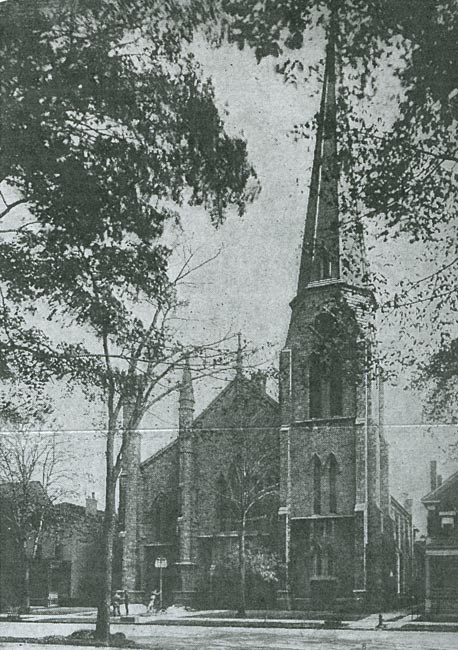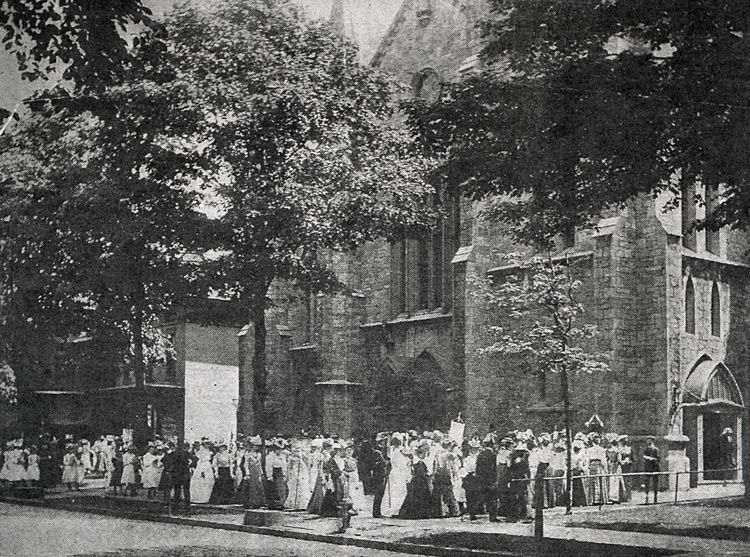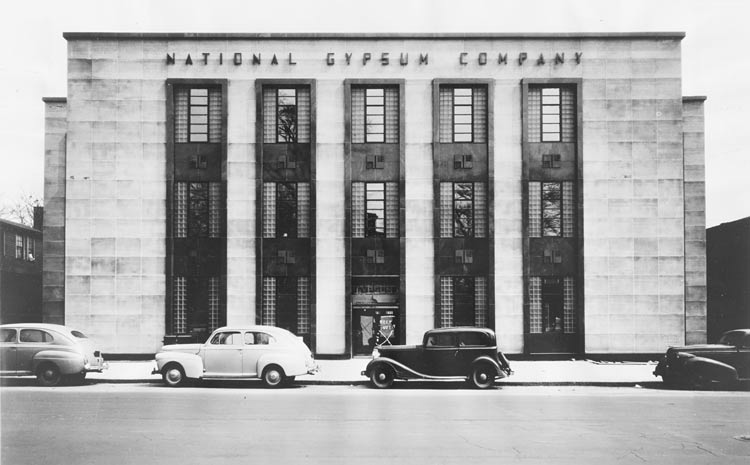325 Delaware: Calvary Presbyterian/National Gypsum

Calvary Presbyterian Church. Image Source: Buffalo Courier
The first structure built at 285-325 Delaware was a Presbyterian Church, an offspring of the First Presbyterian Church in Shelton Square. At the time of its construction, in 1862, the location was considered "uptown," Delaware Avenue being entirely residential and surrounded by undeveloped land.

Children's Day, 1895
Prominent Buffalonians called Calvary Presbyterian their own, including Charlotte Mulligan who sang in the choir for years and assisted in raising a $15,000 maintenance fund; George N. Pierce, member of the building committee; Mary Larned, who led a singing class. The church was most fortunate in having a benefactor in the person of George Palmer, a member from the church's earliest inception in 1854. He was one of the founders of the Marine Midland Bank and served as its president from 1851 to his death in 1864. When fundraising for construction of the church faltered, he purchased the land and paid the $85,000 construction costs.
In its 1890s heyday, the church had 700 members and the largest Sunday School in the city with 450 children who formed an orchestra and edited a magazine.

Interior, Calvary Presbyterian Church
But the expansion of the business sector of the city meant that Calvary Presbyterian became a "downtown" church by 1912. In the previous twenty years, 15 Protestant churches located below Tupper Street, 4 of them Presbyterian, had moved farther uptown. Members moved away from the neighborhood; the church became surrounded by businesses and rooming houses. Despite the resulting decline in membership, the church worked to adapt to the new community with evening services and new organizations.
Expenses mounted, a mortgage was taken out with Buffalo Savings Bank, but there was no hope for long-range fiscal solvency. In December, 1940, faced with a $100,000 mortgage, the remaining 62 members voted unanimously to dissolve and surrender the building to the bank.

New headquarters, National Gypsum, 1942. Image source: private collection.
Buffalo Savings Bank wasted no time, beginning demolition of the 79-year-old church three months after its last service. Construction started within a year on the national headquarters of the National Gypsum Company, founded in Clarence Center, NY in 1925 by Melvin Baker, Joseph F. Hagerty, and Clarence Williams, former executives of Beaverboard who lost their positions in a company reorganization. After some trial and error, they developed wallboard, a gypsum mixture pressed between sheets of heavy paper. They purchased land in Clarence Center where they correctly believed there was gypsum, raised funds to begin production, and met with success. By 1940, National Gypsum (not to be confused with its competitor, Chicago's U.S. Gypsum) had 16 plants in the East, South and Midwest, inlcuding a mine in Nova Scotia. Its sales in 1939 were $15 million dollars, its net profit $1,500,000.
The Buffalo offfices were largely housed in the Jackson Building on Delaware Avenue. The new headquarters building would allow the company to double its staff and consolidate all under one roof. Backus, Crane and Love were architects of what would be called an "ultra-modern" office building, with "air-, sound-, and light-conditioning." The facade was buff limestone with dark red granite trimmings, glass blocks, bronze ornamentation. The property extended from Delaware to Franklin, providing opportunities for expansion and parking for 150 cars. The building was constructed in just 10 months, rushed to meet wartime contracts which National Gypsum had from the U.S. government.
On the occasion of the company's 50th anniversary in August, 1975, the Buffalo Evening News reported that National Gypsum was "Buffalo's biggest industrial firm." It added, "Occasionally, there are reports that the present management of the company is thinking about moving National Gypsum's headquarters out of Buffalo. Colon Brown, now the chairman, has said there are no such plans 'at the moment' but that it is a subject that has had attention for 10 years.'"
Five months later, 60 top executives were moved to a new headquarters in Dallas, Texas, a state where there was no personal income tax, versus New York's 17%. The company saw the move as a way to give its top executives a 17% raise without additional expenditure. Four hundred employees remained at the Delaware Avenue building, which became the Gold Bond headquarters. Another 650 were employed in plants making Gold Bond products locally.
In 1978, Gold Bond was relocated to Charlotte, North Carolina, closing the plant and 325 Delaware Avenue.(In 1982, the Clarence Center plant closed.) The company donated a vacant 1.3 acre plot along the south side of the building to the Boy Scouts in 1981; in 2007 Uniland constructed a new office building on that land.

325 Delaware in 2011.